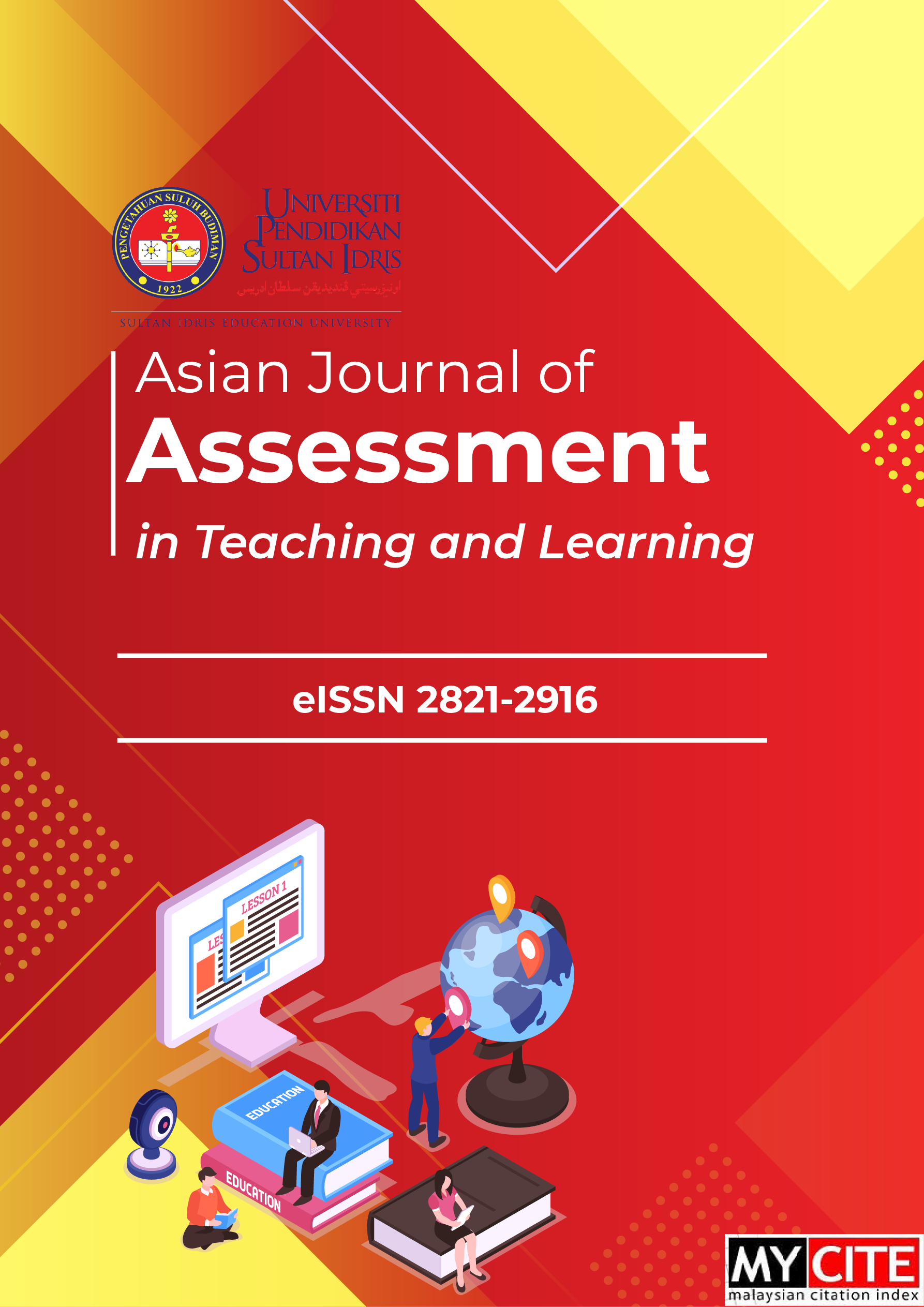Using Response Tokens as a Criterion in an Oral Assessment
DOI:
https://doi.org/10.37134/ajatel.vol14.1.10.2024Keywords:
response token, oral assessment, interactive model, speaking skill, listening skill, active listeningAbstract
This research aims to investigate the use of response tokens as a criterion in an oral assessment. A few research instrument is used in this study to find out the types of response tokens used by English speakers and the reasons behind using them. Besides, this study also helps to determine whether the use of response token has effects on oral assessment and to discover the validity and reliability of their usage. Osgood-Schramm’s Model of Communication is used in the assessment; as in to evaluate speaking skills, listening skills and also the use of response tokens as a part of active listening strategies. Listening skills are often assessed on its own without the integration with other skills in most standard testing, thus this research studies the role of active listening in the oral test. An assessment based on interactive speaking and listening model involving the use of response token is carried out and the results are thematically categorised. The findings from this research proved that the response tokens are actively used as a listening strategy for several different reasons or to convey different meanings and the use of response token as a component in assessment are both valid and reliable. The most significant implication of this finding is on assessment and pedagogical aspect where the importance of response token as one of the measuring components in communicative competence when conducting oral assessments is highlighted.
Downloads
References
Amar, C., Nanbu, Z., & Greer, T. (2021). Proffering absurd candidate formulations in the pursuit of progressivity. Classroom Discourse, 13(3), 264–292. https://doi.org/10.1080/19463014.2020.1798259
Bhatnagar, N. (2011). Effective Communication and Soft Skills. Pearson Education India.
Campbell, S., Greenwood, M., Prior, S., Shearer, T., Walkem, K., Young, S., Bywaters, D., & Walker, K. (2020). Purposive sampling: complex or simple? Research case examples. Journal of research in nursing : JRN, 25(8), 652–661. https://doi.org/10.1177/1744987120927206
De Stefani, E. (2021). Embodied Responses to Questions-in-Progress: Silent Nods as Affirmative Answers. Discourse Processes, 58(4), 353–371. https://doi.org/10.1080/0163853x.2020.1836916
Ebshiana. A., (2020)Response Tokens and Their Sequential Action in the Teacher Third Turn (Note 1) A Conversation Analysis Case Study in the EFL Classroom.
Eiswirth, M. E. (2022). Developing and testing interaction-based coding schemes for the analysis of sociolinguistic variation. Language & Communication, 87, 11-28.
Encalada, M. A. R., & Sarmiento, S. M. A. (2019). Perceptions about Self-recording Videos to Develop EFL Speaking Skills in Two Ecuadorian Universities. Journal of Language Teaching & Research, 10(1).
Galaczi, E. D. (2008). Peer–peer interaction in a speaking test: The case of the First Certificate in English examination. Language Assessment Quarterly, 5(2), 89-119.
Galaczi, E. D. (2014). Interactional competence across proficiency levels: How do learners manage interaction in paired speaking tests?. Applied linguistics, 35(5), 553-574.
Gan, Z. (2010). Interaction in group oral assessment: A case study of higher- and lower-scoring students. Language Testing, 27(4), 585–602. https://doi.org/10.1177/0265532210364049
Gardner, R. (2001). When listeners talk : response tokens and listener stance. Amsterdam Benjamins.
Gardner, R. (2007). The Right connections: Acknowledging epistemic progression in talk. Language in Society, 36(3), 319-341.
Goh, C. C., & Vandergrift, L. (2021). Teaching and learning second language listening: Metacognition in action. Routledge. In J. (2017). Introduction of a pilot study. Korean journal of Anesthesiology, 70(6), 601–605. https://doi.org/10.4097/kjae.2017.70.6.601
Huq, R.-U., & Amir, A. (2015). When the Tokens Talk: IRF and the Position of Acknowledgement Tokens in Teacher-Student Talk-in-Interaction. Novitas-Royal (Research on Youth and Language), 9(1), 60-76.
IELTS. (2024) IDP IELTS; and Cambridge University Press & Assessment. Retrieved from https://ielts.idp.com/malaysia/results/scores/speaking
James, L., & Vo, H. (Eds.) (2010). Hawthorne effect: Encyclopedia of Research Design . (Vols. 1-0). SAGE Publications, Inc., https://dx.doi.org/10.4135/9781412961288
Jongerius, C., Hessels, R. S., Romijn, J. A., Smets, E. M. A., & Hillen, M. A. (2020). The Measurement of Eye Contact in Human Interactions: A Scoping Review. Journal of Nonverbal Behavior, 44(3), 363–389. https://doi.org/10.1007/s10919-020-00333-3
Jonsson, A. & Svingby, G. (2007), “The use of scoring rubrics: Reliability, validity and educational consequences”, Educational Research Review, 2(2), pp. 130-144
Li, W. (2011). Validity Considerations in Designing an Oral Test. Journal of Language Teaching and Research, 2(1), 267–269. https://doi.org/10.4304/jltr.2.1.267-269
Malyuga, E. N., & McCarthy, M. (2021). “No” and “net” as response tokens in English and Russian business discourse: In search of a functional equivalence. Russian Journal of Linguistics, 25(2), 391–416. https://doi.org/10.22363/2687-0088-2021-25-2-391-416
Moskal, B., & Leydens, J. (2000). Scoring Rubric Development: Validity and Reliability. Practical Assessment Research and Evaluation, 7.
Neyer, Anne-Katrin & Harzing, Anne-Wil. (2008). The impact of culture on interactions: five lessons learned from the European Commission. European Management Journal. 26. 325-334. 10.1016/j.emj.2008.05.005.
Norrick, N. R. (2012). Listening practices in English conversation: The responses responses elicit. Journal of Pragmatics, 44(5), 566-576.
Panadero, E., & Jonsson, A. (2020). A critical review of the arguments against the use of rubrics. Educational Research Review, 30
Reddy, Y. M., & Andrade, H. (July 01, 2010). A review of rubric use in higher education. Assessment & Evaluation in Higher Education, 35, 4, 435-448
Ryan, J. (2022). Listening in interaction: reconceptualizing a core skill. ELT Journal.
Sørensen, S. S. (2021). Affiliating in Second Position: Response Tokens with Rising Pitch in Danish. Research on Language and Social Interaction, 54(1), 101–125. https://doi.org/10.1080/08351813.2020.1864159
Ugiljon, A., Anakhon, I., Gulnoza, S. (2018). The Effective Speaking Testing Techniques in Teaching English. International Journal of Secondary Education, 6(1), 24-28. https://doi.org/10.11648/j.ijsedu.20180601.15
Ulker, V. (2017). The Design and Use of Speaking Assessment Rubrics. Journal of Education and Practice.
University of Cambridge. (2009). Examples of speaking performance at CEFR levels. Retrieved from https://www.cambridgeenglish.org/images/22649-rv-examples-of-speaking-performance.pdf
Xiaoxian, G., & Yan, J. (2010). Interactive Listening: Construct Definition and Operationalization in Tests of English as a Foreign Language. Chinese Journal of Applied Linguistics (Foreign Language Teaching & Research Press), 33 (6)
Walsh, S. (2011a). Exploring classroom discourse: Language in action. Taylor & Francis.https://doi.org/10.3138/cmlr.67.4.536
Downloads
Published
Issue
Section
License
Copyright (c) 2024 Rubini Radza, Afza Diyana Abdullah , Qiu XiaoTing

This work is licensed under a Creative Commons Attribution-NonCommercial-ShareAlike 4.0 International License.





